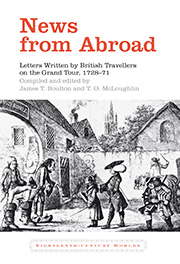Book contents
- Frontmatter
- Contents
- Preface
- Illustrations
- Acknowledgements
- ‘Old Style’ and ‘New Style’ Dating
- Map
- Introduction: The Grand Tour
- The Tourists and Their Letters
- George Lyttelton (1709–73): Letters (1728–30)
- Joseph Spence (1699–1768): Letters (1730–3)
- James Boswell (1740–95): Letters (1764–6)
- James Barry (1741–1806): Letters (1765–71)
- Caroline Lennox (1723–74): Letters (1766–7)
- Appendix A The Hazards of Collecting Art on the Grand Tour
- Appendix B Advice to Travellers on the Grand Tour
- Bibliography
- Index
Appendix A - The Hazards of Collecting Art on the Grand Tour
- Frontmatter
- Contents
- Preface
- Illustrations
- Acknowledgements
- ‘Old Style’ and ‘New Style’ Dating
- Map
- Introduction: The Grand Tour
- The Tourists and Their Letters
- George Lyttelton (1709–73): Letters (1728–30)
- Joseph Spence (1699–1768): Letters (1730–3)
- James Boswell (1740–95): Letters (1764–6)
- James Barry (1741–1806): Letters (1765–71)
- Caroline Lennox (1723–74): Letters (1766–7)
- Appendix A The Hazards of Collecting Art on the Grand Tour
- Appendix B Advice to Travellers on the Grand Tour
- Bibliography
- Index
Summary
COLLECTING ART ON THE GRAND TOUR
THE REASONS for collecting classical and Renaissance works of art in eighteenth-century Britain are many and complex. One could argue that the trend had been set by King Charles I, who started by purchasing ‘the entire cabinet of the Duke of Mantua, consisting of eighty-two pictures, and esteemed the most valuable in Europe, for which he paid £20,000’. Not far below the surface of the burgeoning interest was an awareness that British achievements in painting and sculpture did not yet rival those of France or Italy. The Reformation had been a major factor in explaining the decline of art in Britain and distinguishing it from art in Continental Europe. The 1688 Revolution marked the turning point, after which Britain gradually acquired a more confident outward-looking identity. As one critic puts it, the new ‘Great Britain’ was based ‘on a Protestant culture, which was seen as providing the basis for free enquiry and commercial success’. Commerce brought considerable prosperity to the upper classes, along with a desire for improvement. Hence, the Grand Tour was not just an opportunity for the traveller's self-improvement, but part of a larger trend to re-establish links with certain aspects of European culture.
There were various ways in which this became apparent, but for our purposes three interlinking factors are of particular interest.
- Type
- Chapter
- Information
- News from AbroadLetters Written by British Travellers on the Grand Tour, 1728–71, pp. 260 - 269Publisher: Liverpool University PressPrint publication year: 2012

